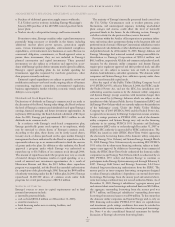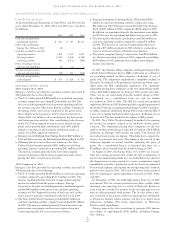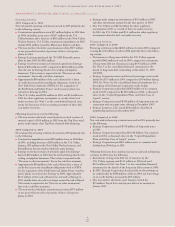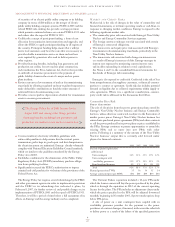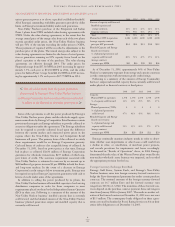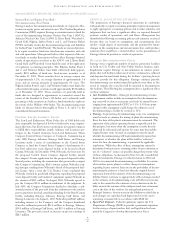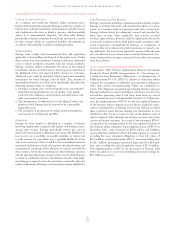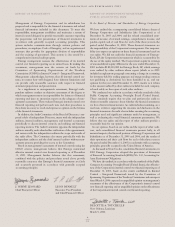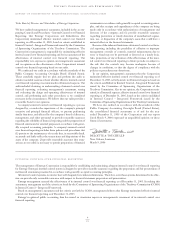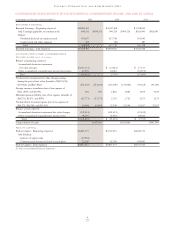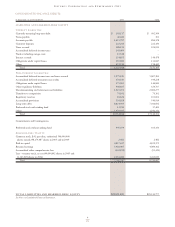Entergy 2005 Annual Report Download - page 53
Download and view the complete annual report
Please find page 53 of the 2005 Entergy annual report below. You can navigate through the pages in the report by either clicking on the pages listed below, or by using the keyword search tool below to find specific information within the annual report.
ENTERGY CORPORATION AND SUBSIDIARIES 2005
*
49
Interest Rate and Equity Price Risk –
Decommissioning Trust Funds
Entergy’s nuclear decommissioning trust funds are exposed to fluc-
tuations in equity prices and interest rates. The Nuclear Regulatory
Commission (NRC) requires Entergy to maintain trusts to fund the
costs of decommissioning Arkansas Nuclear One Unit 1 (ANO 1),
Arkansas Nuclear One Unit 2 (ANO 2), River Bend, Waterford 3,
Grand Gulf, Pilgrim, Indian Point 1 and 2, and Vermont Yankee
(NYPA currently retains the decommissioning trusts and liabilities
for Indian Point 3 and FitzPatrick). The funds are invested primari-
ly in equity securities; fixed-rate, fixed-income securities; and cash
and cash equivalents. Management believes that exposure of the var-
ious funds to market fluctuations will not affect Entergy’s financial
results of operations as it relates to the ANO 1 and 2, River Bend,
Grand Gulf, and Waterford 3 trust funds because of the application
of regulatory accounting principles. The Pilgrim, Indian Point 1
and 2, and Vermont Yankee trust funds collectively hold approxi-
mately $952 million of fixed-rate, fixed-income securities as of
December 31, 2005. These securities have an average coupon rate
of approximately 5.2%, an average duration of approximately 5.6
years, and an average maturity of approximately 9.2 years. The
Pilgrim, Indian Point 1 and 2, and Vermont Yankee trust funds also
collectively hold equity securities worth approximately $519 million
as of December 31, 2005. These securities are generally held in
funds that are designed to approximate or somewhat exceed the
return of the Standard & Poor’s 500 Index, and a relatively small
percentage of the securities are held in a fund intended to replicate
the return of the Wilshire 4500 Index. The decommissioning trust
funds are discussed more thoroughly in Notes 1, 8, and 15 to the
consolidated financial statements.
CENTRAL STATES COMPACT CLAIM
The Low-Level Radioactive Waste Policy Act of 1980 holds each
state responsible for disposal of low-level radioactive waste originat-
ing in that state, but allows states to participate in regional compacts
to fulfill their responsibilities jointly. Arkansas and Louisiana par-
ticipate in the Central Interstate Low-Level Radioactive Waste
Compact (Central States Compact or Compact). Commencing in
early 1988, Entergy Arkansas, Entergy Gulf States, and Entergy
Louisiana made a series of contributions to the Central States
Compact to fund the Central States Compact’s development of a
low-level radioactive waste disposal facility to be located in Boyd
County, Nebraska. In December 1998, Nebraska, the host state for
the proposed Central States Compact disposal facility, denied
the compact’s license application for the proposed disposal facility.
Several parties, including the commission that governs the compact
(the Compact Commission), filed a lawsuit against Nebraska seek-
ing damages resulting from Nebraska’s denial of the proposed facil-
ity’s license. After a trial, the U.S. District Court concluded that
Nebraska violated its good faith obligations regarding the proposed
waste disposal facility and rendered a judgment against Nebraska in
the amount of $151 million. In August 2004, Nebraska agreed to
pay the Compact $141 million in settlement of the judgment. In
July 2005, the Compact Commission decided to distribute a sub-
stantial portion of the proceeds from the settlement to the nuclear
power generators that had contributed funding for the Boyd County
facility, including Entergy Arkansas, Entergy Gulf States, and
Entergy Louisiana. On August 1, 2005, Nebraska paid $145 million,
including interest, to the Compact, and the Compact distributed
from the settlement proceeds $23.6 million to Entergy Arkansas,
$19.9 million to Entergy Gulf States, and $19.4 million to Entergy
Louisiana. The proceeds caused an increase in pre-tax earnings of
$28.7 million.
CRITICAL ACCOUNTING ESTIMATES
The preparation of Entergy’s financial statements in conformity
with generally accepted accounting principles requires management
to apply appropriate accounting policies and to make estimates and
judgments that can have a significant effect on reported financial
position, results of operations, and cash flows. Management has
identified the following accounting policies and estimates as critical
because they are based on assumptions and measurements that
involve a high degree of uncertainty, and the potential for future
changes in the assumptions and measurements that could produce
estimates that would have a material effect on the presentation of
Entergy’s financial position or results of operations.
NUCLEAR DECOMMISSIONING COSTS
Entergy owns a significant number of nuclear generation facilities
in both its U.S. Utility and Non-Utility Nuclear business units.
Regulations require Entergy to decommission its nuclear power
plants after each facility is taken out of service, and money is collected
and deposited in trust funds during the facilities’ operating lives in
order to provide for this obligation. Entergy conducts periodic
decommissioning cost studies (typically updated every three to five
years) to estimate the costs that will be incurred to decommission
the facilities. The following key assumptions have a significant effect
on these estimates:
■Cost Escalation Factors – Entergy’s decommissioning revenue
requirement studies include an assumption that decommission-
ing costs will escalate over present cost levels by annual factors
ranging from approximately CPI-U to 5.5%. A 50 basis point
change in this assumption could change the ultimate cost of
decommissioning a facility by as much as 11%.
■Timing – In projecting decommissioning costs, two assumptions
must be made to estimate the timing of plant decommissioning.
First, the date of the plant’s retirement must be estimated. The
expiration of the plant’s operating license is typically used for
this purpose, but more often the assumption is made that the
plant will be relicensed and operate for some time beyond the
original license term. Second, an assumption must be made
whether decommissioning will begin immediately upon plant
retirement, or whether the plant will be held in “safestore”
status for later decommissioning, as permitted by applicable
regulations. While the effect of these assumptions cannot be
determined with precision, assuming either license extension or
use of a “safestore” status can possibly change the present value
of these obligations. As discussed in Note 8 to the consolidated
financial statements, Entergy recorded revisions in 2004 and
2005 to its estimated decommissioning cost liability for certain
of its nuclear power plants to reflect changes in assumptions
regarding license renewal. Increases in the probability of decom-
missioning the plants at a date later than the original license
expiration lowered the estimate of the decommissioning cost
liability. Future revisions to appropriately reflect changes needed
to the estimate of decommissioning costs will affect net income,
only to the extent that the estimate of any reduction in the lia-
bility exceeds the amount of the undepreciated asset retirement
cost at the date of the revision, for unregulated portions of
Entergy’s business. Any increases in the liability recorded due to
such changes are capitalized and depreciated over the asset’s
remaining economic life in accordance with SFAS 143.
■Spent Fuel Disposal – Federal regulations require the U.S.
Department of Energy (DOE) to provide a permanent repository
for the storage of spent nuclear fuel, and legislation has been
passed by Congress to develop this repository at Yucca
MANAGEMENT’S FINANCIAL DISCUSSION and ANALYSIS continued



